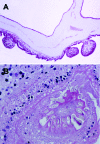Cerebellar cysticercosis caused by larval Taenia crassiceps tapeworm in immunocompetent woman, Germany
- PMID: 24274258
- PMCID: PMC3840866
- DOI: 10.3201/eid1912.130284
Cerebellar cysticercosis caused by larval Taenia crassiceps tapeworm in immunocompetent woman, Germany
Abstract
Human cysticercosis caused by Taenia crassiceps tapeworm larvae involves the muscles and subcutis mostly in immunocompromised patients and the eye in immunocompetent persons. We report a successfully treated cerebellar infection in an immunocompetent woman. We developed serologic tests, and the parasite was identified by histologic examination and 12s rDNA PCR and sequencing.
Keywords: Germany; PCR; Taenia crassiceps; central nervous system; cerebellar infection; cysticercosis; immunocompetent; molecular identification; parasites; tapeworm; zoonosis.
Figures


References
-
- Heldwein K, Biedermann HG, Hamperl WD, Bretzel G, Loscher T, Laregina D, et al. Subcutaneous Taenia crassiceps infection in a patient with non-Hodgkin's lymphoma. Am J Trop Med Hyg. 2006;75:108–11 . - PubMed
-
- Goesseringer N, Lindenblatt N, Mihic-Probst D, Grimm F, Giovanoli P. Taenia crassiceps upper limb fasciitis in a patient with untreated acquired immunodeficiency syndrome and chronic hepatitis C infection—the role of surgical debridement. J Plast Reconstr Aesthet Surg. 2011;64:e174–6 . 10.1016/j.bjps.2011.02.011 - DOI - PubMed
Publication types
MeSH terms
LinkOut - more resources
Full Text Sources
Other Literature Sources
